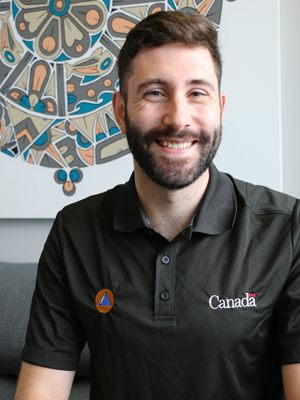When There’s an Emergency
Paul-Émile Auger – CER Emergency Management Specialist

When disaster strikes, we sometimes forget that people involved in the response can also be personally affected as community members. Fires, floods, and pipeline incidents are so much more than just headlines – they are life-changing.
When there is an emergency, it takes more than just a good plan to guide people through. It takes authentic, trust-based relationships. These relationships are vital to not only save lives, but also to minimize short- and long-term impacts.
Paul-Émile Auger is a member of the Canada Energy Regulator’s (CER) Emergency Management (EM) team and is based at the CER’s Eastern Regional Office in Montreal. Building on his previous emergency management role with Indigenous Services Canada, Paul-Émile adds an important dimension to his work thanks to the strong relationships he has built with a number of Indigenous communities in Quebec and Ontario.
“Working with Indigenous communities is a natural extension of my childhood,” says Paul-Émile. “My mother was a renowned anthropologist and growing up, my three siblings and I were exposed to Indigenous cultures from around the world, including the US, Canada, New Zealand and Australia.”
In 2019, a major flooding event in the Kanesatake community and the Municipality of Oka in Quebec reinforced for Paul-Émile the importance of planning and creating bonds with Indigenous peoples. In a matter of hours, the lake rose several meters, homes were flooding quickly, and emotions were running high. The time he invested in training with members of local Indigenous communities, first responders, and even Guatemalan migrant workers resulted in a better outcome for everyone.
“My role in emergency management is a combination of generalist and specialist, there’s the science of risk management but there’s also the practical boots on the ground aspect,” explains Paul-Émile. “There are many variables to manage when a disaster occurs. It can feel chaotic, even if you are well prepared. Initially you get people evacuated including those who don’t want to or are unable to leave. Then you work to keep the community safe against looting, bring in needed supplies, and basically do whatever you can to get through the event. When the emergency response phase is over, we go back to the table to look at what worked and what can be improved for next time.”
Paul-Émile has both a philosophical and practical approach to his work. In August, he started a temporary assignment to support the regional response to forest fires in Ontario.
“I am humbled by the opportunity to share what I know about emergency management – especially in remote communities that are vulnerable, and proud to work with an organization that is constantly evolving and leading by example.”
Visit our website for more information on our role in Emergency Management and the steps we are taking towards Reconciliation with Indigenous peoples of Canada.
- Date modified:
